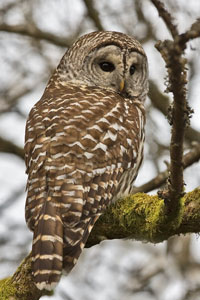

|
Barred Owl (Strix varia) Also know as the Swamp Owl, Striped Owl, Hoot Owl, Eight Hooter, Round Headed Owl, and Rain Owl
Named after the bars on its chest the Barred Owl is the most vocal of Eastern owls. It is sometimes called the laughing owl due to its many vocalizations (sounds it makes). Its call sounds like, "Who cooks for you? Who cooks for you all?" People often mistake the Barred Owl for a Spotted Owl. See if you can find the differences between the two species. Where they live: Barred owls live in forested areas, from swamps to uplands. They may be found in city parks or low-density residential areas with forest patches. Click the map for information about the habitat and range of the Barred Owl in Washington. 
What they eat: Small mammals, rabbits, birds, amphibians, reptiles, and invertebrates. Nesting: Barred owls build nests in cavities of large trees or uses open nest made by a hawk or crow. They also use nest boxes. The Barred Owl usually nests between February and May. The owl lays 1 to 5 white eggs. Both adults incubate the eggs for about 28 days when the eggs hatch. The young can fly at 42 days old. Behavior: The Barred Owl is familiar for its distinctive "who-cooks-for-you, who-cooks-for-you-all" hooting. They can be seen wading in water to catch crayfish. Did you know?
Animal silhouettes available to purchase » Photo Credit: Natures Pics Home | About Us | How to Participate | Biodiversity Modules | Projects | Maps | News | Resources |